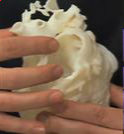復調で来たテキストは以下の通り。
Welcome to VOA Radiogram number 20.
Here is the lineup for today's program...
2:30 MFSK16: Program preview
5:22 MFSK32: VOA News re 3D printed heart
1:00 MFSK32: Heart image
4:15 MFSK64: VOA News re oxygen in Mars's past
1:15 MFSK32: Mars image
7:00 EasyPal image*
1:08 MFSK16: closing announcements
1:17 MFSK32: VOA Radiogram logo
:55 Surprise mode of the week
*Download EasyPal software from vk4aes.com.
Please send reception reports to radiogram@voanews.com
And visit voaradiogram.net
Twitter: @VOARadiogram
Next on VOA Radiogram, VOA News in the MFSK32 mode...
Sending Pic:283x44C;

3D Printers Help Heart Surgeons
George Putic KI4FNF
July 30, 2013
WASHINGTON — 3D printers are slowly entering everyday life and
they are increasingly being used in medicine. Doctors at
Washington's Children's National Medical Center say the life-size
tri-dimensional prints of their patients' hearts helps them in
planning and executing surgeries.
Magnetic resonance imaging, computer tomography and ultrasound
already give pretty good images of patients' internal organs, but
doctors at the Children's National Medical Center say nothing
beats holding a life-size model of a heart in your hand prior to
the surgery. They can study it, plan the procedure and even
practice the access to the damaged area.
Pediatric cardiologist Laura Olivieri says many of their young
patients were born with hearts that did not form as they should
have, but surgeons can correct that.
"Seeing the heart defect in three dimensions can really help the
interventionist or the surgeon plan the best procedure," she
said.
The hospital acquired the $250,000 printer about 18 months ago
and the team is still expanding and finding new areas to print.
The procedure always starts with taking a set of
three-dimensional images with magnetic resonance imager, computer
tomography scanner and ultrasound machine. Highly trained
pediatric cardiologists manipulate those images and separate the
organ from the noise in the picture. In order to save time in
printing they sometimes also cut away parts of the image
irrelevant to the planned procedure.
"It takes us now about an average I would say about two hours of
manual work on the computer to manipulate the data in to generate
the 3D model and the printer takes about, for a full size heart
like this, it takes about 12 hours," said mechanical engineer
Alex Krieger, the principal investigator for pediatric surgical
innovation at the Children's National Medical Center. "A smaller
heart maybe five, six hours."
Krieger says in one instance his team printed a model of the
heart of a patient with stenosis, or narrowing of the passage
between two heart chambers. The interventional cardiologist
wanted to see exactly what kind of stent he should use, the size
and length of it, and also the access path.
"So this model allowed him to really look at that in depth and
plan, and prepare for the procedure better," he said.
The machine prints by spraying layers of plastic, one on top of
the other, while the ultraviolet light immediately cures it
before the next layer is sprayed. Krieger says the printer can be
loaded with two different materials. Precise control of their
ratio allows the printed model to feel very natural, with both
hard and soft tissues.
Cardiologist Olivieri says doctors still have to learn a lot
about the new procedure.
"It's a brand new field. These have only been possible for a wery
little amount of time and I don't think we even know the full
capability of what we're going to be... what they're going to be
used for," she said. "We're kind of talking about a technology
that went going from feasible to kind of usable and we're right
in that middle ground right now."
There is also hope that someday hospitals will be able to print
even replacement parts for damaged organs.
"There's eventually some organ printing, you know, that's the
ultimate goal, but I think there are a few steps between that we
will reach in the next few years, on the way to full organ
printing that I'm very excited about," said Krieger.
http://www.voanews.com/content/three-d-printers-heart-surgery/1713293.html
Sending Pic:124x134C;

VOA Radiogram now changes to the MFSK64 mode, with a VOA News
story in the Flmsg format...
... start
[WRAP:beg][WRAP:lf][WRAP:fn Mars_test.p2s]
:hdr_fm:20
MFSK 20133107142127
:hdr_ed:20
MFSK 20133107113849
plaintext
:to:28 Worldwide shortwave audience
:fm:13 VOA Radiogram
:dt:15 3-4 August 2013
:tm:38 Sat 1600, Sun 0230, Sun 1300, Sun 1930
:sb:46 VOA News: Mars Once Had Oxygen-Rich Atmosphere
:mg:5559
Voice of America
Mars Once Had Oxygen-Rich Atmosphere
Rick Pantaleo
July 30, 2013
New research by scientists at Oxford University in England has revealed that Mars may
have also had an oxygen-rich atmosphere about four billion years ago, nearly 1.5
billion years before Earth developed its atmospheric oxygen.
The scientists, led by Professor Bernard Wood, first studied the chemical composition
of Martian meteorites that fell to Earth, which they say probably came from the deep
interior of Mars. They made a similar examination of rocks that were found on the
surface of Mars with data provided by NASA's 'Spirit' rover. After comparing the
composition of both forms of Martian rock, they found that those from the surface
came from a more oxygen-rich environment.
Wood described the Martian rocks from meteorites as geologically 'young', around 180
million to 1.4 billion years old, and those found and analyzed by the Spirit rover
was from what was said to be very old part of Mars, more than 3.7 billion years old.
The principal difference in chemical composition between the meteorite and surface
rocks that he and his team noticed was in the concentration of nickel.
According to their analysis, the surface rocks had about five times as much nickel as
the Martian meteorite, something they thought was puzzling, and made them wonder
whether the meteorites are typical volcanic products of the red planet.
"What we have shown is that both meteorites and surface volcanic rocks are consistent
with similar origins in the deep interior of Mars, but that the surface rocks come
from a more oxygen-rich environment, probably caused by recycling of oxygen-rich
materials into the interior," said Wood.
Here on Earth, the method in which oxidized material can get recycled into the
interior is something called subduction, which Wood describes as the process where
old crust is pushed back down into the interior of the planet. The newly reintroduced
oxidized material, he said, has an effect on the kind of material produced in the
interior that is later brought back to the surface through volcanic activity.
The researchers believe that same processes took place on Mars during its early
history, explaining why some Martian rock came from an oxygen rich environment while
others did not.
Why is Mars the red planet?
Scientists say that the reddish hue of Mars surface is the result of oxidized iron -
rust. This alone could show that the planet must have had oxygen available at least
some time in its history.
So, where did the oxygen on come from?
Here on Earth, our oxygen was first produced as a result of the photosynthesis of
early microbes. But that's not how Mars got its oxygen.
"It would be very interesting if one could assert that the same thing, that microbes
were involved on Mars, but in fact, the principle origin of oxygen was probably from
the breakdown of water into oxygen plus hydrogen," said Wood. "This happens in the
atmosphere all the time, it's happening on Earth right now; water is broken down into
oxygen plus hydrogen and some hydrogen escapes from the Earth, leaving a small amount
of remaining oxygen in the atmosphere." The breakdown of the water into its basic two
elements is caused by the Sun's radiation.
Wood thinks that this same process had to have happened on Mars as well, if there was
water vapor in the Martian atmosphere. He adds that the big difference is that on
Mars, it's easier for the hydrogen to escape, because of its weaker gravity.
"So, as long as there was water around on Mars, the water vapor in the atmosphere,
there would be continuous production of oxygen due to the breakdown of water into
oxygen plus hydrogen," said Wood.
Losing oxygen
Unlike Earth though, Mars lost its atmospheric oxygen. Wood says this was due to its
reaction to the surface of planet.
As mentioned earlier, Mars got its reddish hue due to the oxidation of iron contained
in its rocks and soil. It was that oxidation process that eventually robbed Mars of
its oxygen, according to Wood. Water that was present on the surface of early Mars
also disappeared as a reaction with the rocks. "So, water is consumed, carbon dioxide
is to some extent consumed and the oxygen is consumed by reaction between oceans and
atmospheres and the rocks," said Wood.
While the same processes are happening on Earth, the difference is that here there is
continuous production of more water and carbon dioxide due to volcanic activity, so
there is continuous replenishment of each.
Wood said that Mars didn't have the same advantage of having these elements replenish
ed. Unlike Earth, Mars, a smaller planet, quickly became much colder.
As it cooled down the amount of volcanism reduced, its water and carbon dioxide were
not replaced efficiently.
Eventually, the amount of water and CO2 being replaced by this process would have
become very small, and so gradually all of the water and carbon dioxide would have
been consumed.
This would have caused a thinning of Mars' atmosphere, making its surface even
colder, producing a negative greenhouse effect, making it impossible for the planet
to retain any of the Sun's heat.
The study that chronicled the research and findings by Wood's research team was
published recently in the journal, Nature.
www.voanews.com/con
tent/mars-oxygen/1713223.html
voaradiogram.net
[WRAP:chksum F6F6][WRAP:end]
... end

Sending Pic:150x144C;
Please send reception reports to radiogram@voanews.com
And visit voaradiogram.net
Next on VOA Radiogram is an image in the EasyPal digital mode.
Its duration is 7 minutes, 5 seconds.
Please send reception reports to radiogram@voanews.com.
And visit voaradiogram.net.
Twitter: @VOARadiogram
Thanks to colleagues at the Edward R. Murrow shortwave
transmitting station in North Carolina.
I'm Kim Elliott. Please join us for the next VOA Radiogram.
This is VOA, the Voice of America.
Sending Pic:500x44C;

Thank you or decoding the modes on VOA Radiogram via the Edward
R Murrow transmitting station in North Carolina.

